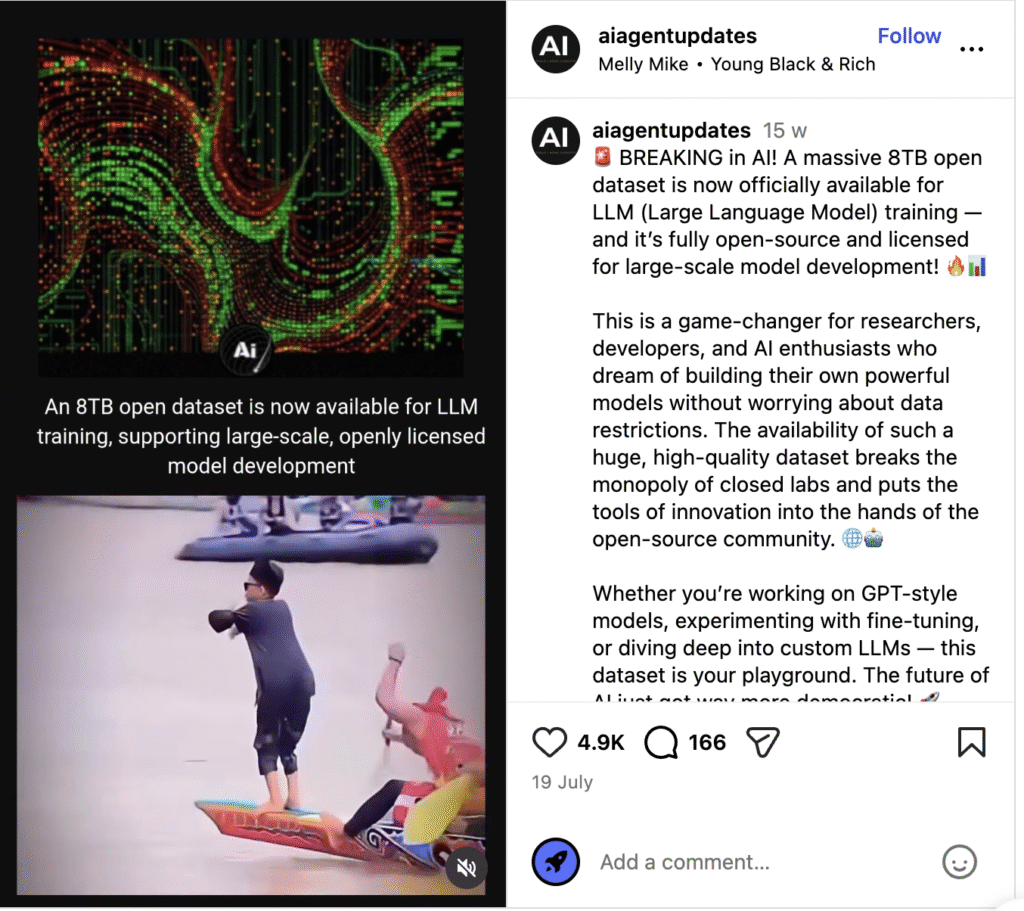Introduction
The open-source AI world just got a massive upgrade.
EleutherAI, one of the most respected names in open research, has released The Common Pile v0.1, an 8-terabyte dataset made up entirely of public domain and openly licensed text.
This release is a breakthrough moment for anyone building LLMs (Large Language Models). For the first time, developers can train large-scale models on a dataset that is legally safe, ethically sourced, and openly available.
In an era when copyright lawsuits are reshaping how AI companies handle data, The Common Pile represents the next evolution in transparent AI development.
The Common Pile v0.1 – What It Is
The Common Pile is an open dataset designed for training language models without legal risk.
It combines text from over 30 public and open sources, everything from academic papers and code repositories to government documents and educational materials.
Key Details
- 💾 Size: 8 terabytes of clean, open text
- 🧠 Purpose: Safe, large-scale language model training
- 🏛️ Sources: Public domain and open-license materials only
- ⚖️ Licensing Policy: Compliant with the Open Definition 2.1, meaning all content can be freely used, modified, and shared

EleutherAI also trained two experimental models, Comma v0.1-1T and Comma v0.1-2T, using this dataset.
Early benchmarks suggest they perform comparably to models trained on unlicensed web scrapes, proving that quality and legality can coexist.
Why This Matters
1. Legal Safety for AI Training
Most AI models today are trained on massive web scrapes that include copyrighted material, books, articles, and user-generated posts. This has sparked a series of legal challenges against major AI labs.
The Common Pile avoids all of that. Every single token is sourced from a legally clear and traceable origin.
2. Ethical and Transparent AI
Transparency is becoming a core pillar of trustworthy AI.
By using only open data, EleutherAI is creating a new standard for model transparency. Developers, regulators, and users can all see what went into the training process, reducing “black-box” ambiguity.
3. Open Ecosystem Collaboration
The release also supports the growing open-source LLM movement, aligning with projects like Mistral, Falcon, and OLMo that promote community-driven AI.
This dataset becomes the foundation layer for legally safe, community-built LLMs.
Inside the 8TB – What’s Included
The dataset spans multiple domains and data types, ensuring broad linguistic and contextual coverage:
- 📚 Open academic research and scientific papers
- 💻 Source code from permissive repositories
- 🗞️ Government and legal documents
- 🎓 Educational and instructional material
- 📜 Public domain literature and cultural texts

That said, researchers have noted some gaps, for instance, informal web text, social dialogue, and non-English data are less represented. This makes it ideal for formal, research-grade models, but less so for conversational or creative LLMs without additional fine-tuning.
Community Reaction-Reddit Speaks
The news lit up Reddit’s r/LocalLLaMA, a community of local AI model builders. The general sentiment: excitement mixed with practical caution.
u/vibjelo:
“First question I had: What license was the ingested text under? which luckily is answered quickly. This is the right direction.”
u/cyberponder:
“I love the transparency, but after browsing some of the raw data, there’s a lot of low-quality, borderline spam content. Needs better filtering.”
u/nerdwithgpu:
“Great step forward for legally clean datasets, but quality control will make or break it. You can’t just ‘open license’ your way to good results.”
These comments highlight both the optimism and realism in the open AI community.
Everyone agrees: legality is the future, but data quality remains the battlefield.
Strengths and Weaknesses
| Aspect | Strengths | Weaknesses |
|---|---|---|
| Legal Clarity | 100% open or public domain data | May limit some diverse data sources |
| Scale | Massive 8TB dataset | Heavy infrastructure needs |
| Transparency | Fully auditable sources | Requires careful curation |
| Quality | Clean licensing; reproducible | Contains some low-value or noisy text |
ToolJunction Take: Why This Release Matters
For builders, researchers, and startup founders, The Common Pile v0.1 signals a shift from data abundance to data accountability.
It’s no longer enough to just collect, you must collect ethically, legally, and strategically.
If you’re developing AI tools or automation systems:
- Start experimenting with open-licensed datasets like this
- Document your data sources publicly, it builds brand trust
- Use this release as a foundation for compliant model training
The future of AI belongs to those who are not just fast, but transparent and principled.
Final Thoughts
The Common Pile v0.1 is far more than a dataset, it’s a milestone for the open AI movement.
It proves that legally clean, openly licensed, and high-performance data pipelines are not only possible but necessary.
The community response shows that people are ready to trade secrecy for sustainability.
As open LLMs continue to evolve, The Common Pile might just become the bedrock of a new, ethical AI ecosystem.
In short: the most powerful AI models of the future won’t just be intelligent, they’ll be accountable.
At tooljunction, we share honest AI tool reviews and tutorials to help you choose the right tools for your creative projects.






